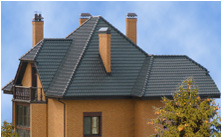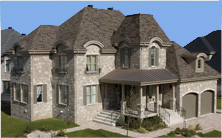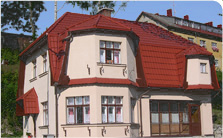Modern roofing materials
Modern roofing materials
Tiles - flat or curved tile of baked clay. Shingles are widely used in many countries around the world from ancient times until today. Tiled roofs are very durable, but heavy: weight of 1 m2 - 50-100 kg. They are placed manually on a frequent and powerful crate. Recommended roof pitch 18-60 ° (in the attic up to 76 °). There are several basic types of tile: flat ribbon and stamped, Dutch, Tatar, etc. Natural color of shingles - from terracotta to sandy yellow. Can be covered with a colored glaze.
Decorative and durable tiles create a halo she aristocracy: they say that "tile is aging with dignity, like good wine." In Russia and then in Russia, ceramic tiles did not have much popularity. One of the reasons noted in the dictionary Dal: "Our frost it (shingles) tears." These days, tile is still one of the most prestigious materials. This circumstance is brought to life a variety of materials that simulate tile: Cement-sand tile, metal, "soft".
Cement-sand tile
Cement-sand tiles produced by many manufacturers. But when choosing the material should be remembered that the quality of cement-sand tiles to a large extent depends on the production technology, and ensure its longevity can only use high quality raw materials and carefully maintaining production schedules of production. An example of high-quality cement-sand tile is a product of "BRAAS-DSC-1.
Stamped Frankfurt tiles made of cement-sand mixture with the addition of mineral pigments. Color Tile classic red, gray stone, etc. Dimensions 330h420 mm form similar to the Dutch ceramic tiles. Flow rate of 1 m 2 - about 10 pieces and weighs 1 pc. - 4,5 kg. Shingles is characterized by high physical and mechanical properties and frost resistance, comparable to ceramic tiles. The firm gives 30-year warranty on the tiled roof in our climate, the life expectancy of a roof - 50 years.
Soft (flexible) tile
Great interest among builders is the so-called soft tile, obtained cuttings from rolled flat sheets of materials that are reminiscent of when laying a roof of natural slate tiles, shingles, or shingles. It should be noted that such materials, at least two reasons not necessary flexibility to such an extent as the rolls. Firstly, such materials are delivered and stacked to the roof in the form of flat sheets of small size (no need to unwind a roll), and, secondly, the deformation of the material in the course of its life on the roof, in a free-fixed tiles does not arise such stresses as in huge cloth roof membrane of the roll materials, leading to tearing and deformation of carpet. Soft piece materials are not new: in the early XX century we have used the tiles from the asphalt breakdown, and in the U.S. - tiles " Shingls .
Roofing (Tolev) failure - faulty sections of roofing material cloth, which were cut from rectangular tiles measuring 75h60 cm, 60x50 cm etc. Roof of them was packed on a continuous sheathing with a slope greater than for the rolled materials, and bypass of a series on another.
Tile "Shingls" (from the English. Shingle - flat roofing tiles, shingles) - is a sheet of cellulose or asbestos cardboard impregnated with natural (trinidatskim ") coated with bitumen and armoring the front of the spreading of the oil shale fines. Sizes of tiles - 90h41 (31) see bottom edge of the tiles - shaped set up after laying the impression flake coating.
Now similar tile improvement of quality of different companies under different names, which can meet not only the word "tile", and "shingles" or "shingls. Typically, this is - Sheet Size (90-100) x (35-40) cm, simulating 4.3 pieces of tile (shingles) of different shapes. Sheets attached to the sheathing with nails, and the connection with each other provide a self-adhesive patches on their lower surface.
Color and rough texture of the front surface reaches the mineral dressing. Companies produce tiles of virtually any color: one color or simulate "bulk" material. There is a version of tiles with outer surface of the metal (copper or aluminum) foil. Roofing materials such wonderfully decorative. Soft tile is more durable than their counterparts in the structure of rolled material due to the fact that it does not form a continuous coating, and material deformation during aging are located in each tile individually, eliminating the violation of coating on the internal stresses. In soft tile roof longevity is likely to be determined by a reduction of decorative due to loss of color spreading tiles.
The ground under the soft tile serves as a solid (usually a plank) crate. The minimum angle of the roof 10-12 °, the maximum - not qualified because this material can cover even the roofs of adjoining parts of the walls. At small angles (18 °) under the soft tile plank should be a layer of rolled material. The complexity of the device roofing is low (weight of 1 m 2 coating of 8-12 kg).
Leading foreign vendors soft tile - a firm Katepal "and" ICOPAL (Finland), "Tegola (Italy)," Onduline (France). In Russia the production of soft tile initiated by "TechnoNIKOL and Ryazan KRZ. But so far the main supplier of soft tile remains in Finland, are sold in Russia to 2 million m2 of soft tile per year.
Metal fragmented
Tile manufacturer in the form of individual plates of metal sheets (such as galvanized steel) practiced for a long time. Now, the term implies large-metal steel sheets stamped in the form of a tiled roof. However, a number of companies producing and fragmented metal tiles of various colors.
Ceramic tile second generation
New on our market of roofing materials - ceramic tiles Ardogres, obtained the technology granite. This material is very durable and beautiful.
Flat metal sheets
Sheet materials as well as custom-made, have deep historical roots: lead, copper and zinc roofs were covered with sheets of unique structures (palaces, cathedrals) many centuries ago. It is interesting that in 1997 the market of roofing materials Russia again had zinc sheets for roofing. Roofs made of nonferrous metals are very durable, but also very expensive. Steel roof, which appeared in the XIX century., First black (require periodic painting) and then a more corrosion-resistant - galvanized, has become the main type of sheeting for roofs. Roofing sheet metal requires a skilled hand, and decorative features such roofs are low. Recommended roof pitch of the steel sheets 14-20 °; weight - 4,5-7 kg/m2. Produced galvanized steel primarily in the form of sheets of 1.25 x 2, 5 m at a thickness of 0.55 mm.
Copper as a roofing material has high architectural significance and is used in exceptional cases (cost of 1 m2 of copper sheet is much higher than that of galvanized steel). Longevity of the roof more than 100 years. Copper roof in the first week has "copper" color, but then darkens, acquiring a dark brown color, eventually copper, covered with patina, acquires a specific blue-gray tint. The main supplier of copper roofing company CPA. Copper is available in rolls 670 mm wide, sheet thickness 0,6 and 0,8 mm. Copper raskislena phosphorus, which removes the appearance of the patina of 20-25 years.
Zinc for the roofing work is used as an alloy with a very small amount (0,1-0,2%) of titanium and copper. These additives impart plasticity of zinc in the cold. In the market of building materials roofing zinc is often called the "zinc-titanium. The largest supplier of roofing zinc Russian-French company UNION ZINC, organized on the basis of MZOTSM. The company produces roofing sheets are folded up to 5h0, 66 m rolls in widths from 0,2 to 0,66; zinc sheet thickness from 0,2 to 1,0 mm. In addition, the elements are made of zinc spillway systems and other accessories. Color zinc sheet roofing, and accordingly can be: natural silvery-shining, rolling over time in the noble matt light gray, matte light-slate, matte gray and charcoal.
Zinc is recommended for devices roofs of any configuration with a slope of not less than 5% on solid foundation. Zinc roofs are highly durable - up to 100 years or more. Zinc roof in Moscow can be seen on the buildings of the Historical Museum, the Hotel Baltschug and other facilities.
Profiled sheets - profiled
A special place among the leafy roofing materials occupy a profiled steel sheets produced from various materials. The simplest option - corrugated sheets of galvanized steel and aluminum sheet. Profile (wave) on these materials, besides giving them rigidity, makes it easy to dock sheets (stacking overlap) and creates an additional decorative effect. Laying profiled sheets produced by bruschatoy crate directly or glassine layer (roofing) with special nails. Possible flooring profile sheet on the old roll and other types of roofs. One of the first profiled sheet materials are asbestos cement sheets. Followed by sheeting appeared corrugated sheets of galvanized steel, aluminum, plastic sheets (eg, fiberglass, PVC, polycarbonate, etc.), bitumen-cardboard corrugated sheets - Ondulin and its analogs.
In recent years, a new type of sheet materials with a complex profile - metal.
Asbestos cement roofing sheets
Asbestos cement is prepared from a mixture of asbestos SHORT (15%) and Portland (85%). Asbestos-cement corrugated sheets, often called "slate", proved to be durable (50 years), technological and enough decorative material. They are recommended for roofs with a slope of more than 12 °; weight of 1 m2 of the roof - 10-14 kg.
Strongly mussiruemoe in recent years the view of the harmfulness of asbestos due to the presence of asbestos in them devoid of substantial grounds and is dictated purely opportunistic reasons: in Russia are the largest deposits of asbestos, while in most developed countries there is practically no asbestos. In addition, asbestos-cement products is tied up and not released to the environment.
The domestic industry produces several types and sizes of asbestos-cement sheets: length from 1200 to 2500 mm and thickness from 5,5 to 8,0 mm, respectively. Sheets are fixed on bruschatoy crate special "slate" nails.
To improve durability and make decorative asbestos sheets cover painting structures or dye in the mass. One of the latest developments leading manufacturer of asbestos ZAO Krasny builder "(Voskresensk) - Slate" New ", asbestos cement corrugated sheets, painted polimerfosfatnoy paint" Polifan (brownish-red, green, blue and other colors). Paint layer reduces water absorption, frost resistance of asbestos increases and prolongs its life in 1,3-1,5 times.
Gofrolisty with bitumen-impregnated
Corrugated cardboard sheets on the basis of bitumen-impregnated and decorative front surface produced by many companies under different names: Online, Euroline, Ondura etc. championship in this area belongs to the French firm "Onduline, generating more than 50 years of material under this name.
Ondulin - flexible, corrugated sheets, molded from cellulosic fibers and impregnated with bitumen. The face sheets are covered with protective and decorative colored layer based thermoset (vinyl acrylic) polymer light-resistant pigments to color: red, brown, green and black. Produced sheets with a single painting with a matte texture surface, and double ("Ondulin Suite"), with more vivid color and greater durability. Ondulin that looks like asbestos sheets, much easier for them, and deprived of fragility. Size sheets Ondulin 2000h940 mm thickness (2,7 ± 0,2) mm. Roofing of Ondulin one of the easiest - weight of 1 m2 of about 3 kg. Heat resistance Ondulin not lower than 110 ° C. The minimum roof pitch of Onduline is 6 °. When deviations from 6 to 10 ° Ondulin recommended to lay on a continuous sheathing with a longitudinal overlap of at least 300 mm, with a slope of 10 to 15 ° it is placed on bruschatoy crate with a step of 450 mm, and for large deviations - at 600 mm. The low weight and ease of installation Ondulin can be used as new roofing directly over the old (eg, reels, etc.). Possible to use Ondulin for lining the walls. Mounting plates in all cases the nails with plastic washers. Sheets if necessary easily cut with an ordinary saw or sharp knife. Ondulin used as roofing material in the individual low-rise construction, agricultural, construction and architecture of small forms in many countries with both hot and cold climates.
Metal
Innovative roofing sheet material - metal - the development of the idea of corrugated roofing sheet in the direction of enhancing its decorative effect. For this large-galvanized steel (or aluminum) sheet coated with an anticorrosive primer composition on both sides, punched in the form of an area tile roofing in various fields, the front of the cover painting structures based on polymeric binder, a mineral pigment and filler, simulating both color tiles, and in some cases, its texture. As a binder in a layer of personal use thermosetting oligomers: polyester, epoxy, polyurethane, plasticized PVC (the so-called plastisol), acrylic polymers, etc. Polyester coating (polyester) has a thickness of about 25 microns, polyurethane (half-frames) - 50 microns, the last gives more stable and flexible film. Plastisol coating is very thick - 200 microns. It is elastic and may have a textured surface. From a decorative standpoint, the most interesting coverage of a transparent acrylic resin with colored mineral coating, which creates the effect of surface ceramic material (so-called covered with Terra).
Metal recommended for roofs with a slope of not less than 14 °. When the device insulated roofing metal tile should be done under a ventilated gap, or to provide vapor barrier. Installation of sheet metal is carried out on bruschatoy crate (step 350-500 mm), self-tapping screws.
The roof of metal is very lightweight (about 4-6 kg / m 2 - for steel and up to 1.5 kg / m 2 - for aluminum), decorative and durable (up to 50 years). Operating temperature range for the metal: -40 to +120 ° C. The disadvantage of metal is high compared with other types of roofing noise during rain, snow, progress, etc.
Major manufacturers are supplying metal roofing on the Russian market: Rannila Steel Oy (Finland) and Kami Plegel Roof (Sweden). Began production of metal in Russia.
Membrane coating
For the roofs of industrial, public and other buildings with small slopes and rugged, and dense (eg, concrete) foundations interest membrane coating. Membrane made of elastomeric rubber-like polymer material with a relative elongation of 200-400% and high tensile strength and puncture resistance. Membrane material retains its properties at temperatures from -60 to +100 ° C. Dimensions of panels of such materials until 15h60 m (ie 900 m2).
One of the main advantages of membrane coating is the speed of the device roofing large areas. Banners served on the roof folded, unfold and laid on the ground. Cloth are joined with each other samovulkaniziruyuschimisya ribbons. They also performed contiguity. Possible stacking membranes on the old roof membrane. Prerequisite is a thorough cleaning of the base of the solid particles (stones, etc.). Top prigruzhaetsya membrane and protected from UV radiation backfilling with gravel or concrete tiles. In this case, the roof can be "exploited". Correctly executed roof can last more than 30 years.
The best known membrane EPDM (ethylene-propylene-diene copolymer) coatings firm Firestone. Often in the literature (especially conversion) membranes called the new generation of roll materials on the basis of bitumen modified with polymers.
Mastic roofing
Mastic roofing obtained when applied on the ground (usually concrete) zhidkovyazkih oligomeric products, which harden in the air, form a continuous elastic film. Mastic have good adhesion to concrete, metal, bituminous materials. По сути, мастичные кровельные покрытия – это полимерные мембраны, формируемые прямо на поверхности крыши. Особенно удобны мастичные материалы при выполнении узлов примыкания. Мастики могут быть двухкомпонентные (собственно мастика + отверждающая система), или однокомпонентные, отверждаемые влагой, кислородом или СO2, содержащимися в воздухе.
Общие принципы выбора кровельного материала
Выбирая кровельный материал, проектировщик или архитектор должны четко представлять себе назначение здания (жилое, общественное, вспомогательное и т.п.), желаемую долговечность самого здания и кровельного покрытия, а также конфигурацию крыши, диктуемую эстетическими и утилитарными (например, желанием иметь дополнительную площадь) соображениями.
Критериями для выбора конкретного кровельного материала в таком случае будут: · соответствие материала конфигурации кровли; · соответствие долговечности материала планируемой долговечности кровли и, в особенности, здания в целом; · соответствие материала эстетическим требованиям; · соответствие материала экономическим возможностям застройщика (здесь оценивается стоимость материала, трудоемкость его укладки и сложность конструкции кровли: стропила, обрешетка, долговечность и трудоемкость ремонтных работ).
Источник: СтройБизнесМаркет. 23.8.2004. №33 (419)





